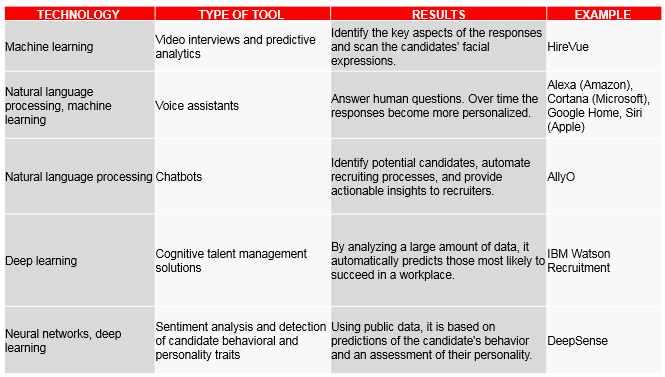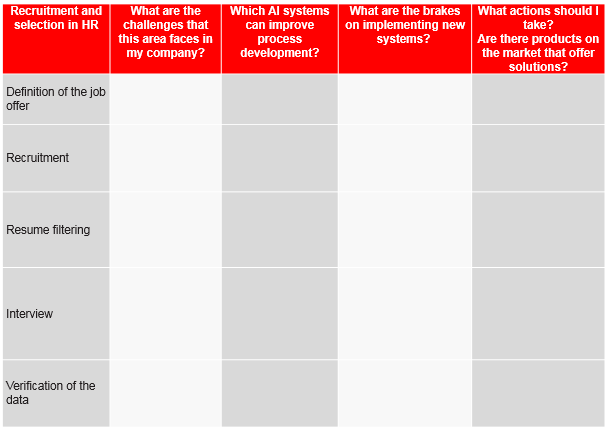
IESE Insight
A guide to using AI in HR for efficiency and effectiveness
Automated processes can save time and money, allowing human beings to focus on adding value at work. A new book helps managers discover how AI can be put to the service of HR or people management now and in the future.
- In the not-too-distant future, some jobs will be for human beings only, while others will be for machines using artificial intelligence (AI). What's important now is for companies to fill new intermediary jobs in which people help machines and vice versa.
- AI can help extract value from the data generated in the recruitment process, making talent searches more effective and efficient.
- AI in HR has already arrived: Unilever has reportedly reduced its recruiters' screening time by 75% thanks to the use of AI in online interviews with candidates.
Even with corporate budgets stretched tight by the COVID-19 crisis, management is making room for artificial intelligence (AI) tools to help automate processes, saving time and money in many areas.
In a new book, IESE professors José Ramón Pin and Guido Stein analyze the advantages that AI can bring to talent recruitment and retention processes, as well as the challenges that companies face in people management.
What talent do I need?
While it's true that automation will eliminate some jobs, AI machines require training, explanations and maintenance, and human beings will fill these new roles. Companies will continue to require analytical and relational skills, and even physical power, thereby consolidating the need for people.
So, there will be jobs that are just for human beings (leading, empathizing, creating and judging) and others for machines (processing, analyzing, relating and adapting). But what's important for companies now is to fill new intermediary jobs -- those in which people help machines to do their work and those in which machines enhance people's capabilities.
Looking for candidates
Attracting the right talent involves a lot of data -- including the company's search processes and data provided by the candidates themselves in their CVs and on social networks. AI can help extract more value from all this information, making the recruitment and selection processes more effective and efficient.
For example, IBM's Watson chatbot, designed to hold conversations with human users, can track information in many documents in minimal time and interact with job candidates. This AI system can also give information to candidates and help guide them to the job openings that might provide a good fit.
Meanwhile, the use of online interviews -- now so prevalent -- can speed up the talent screening process, especially when combined with certain AI tools, such as facial recognition to determine, for example, if a candidate is looking at the camera or reading from a script. There's also the analysis of micro-expressions, which can help identify the personality or thinking style of the interviewees as well as their emotional reactions to questions. The tone of voice in the interview and the choice of words used -- including in email correspondence, social media posts and other interactions -- may also be examined and analyzed.
Companies like Unilever already use these technologies to interview a large number of potential employees, which has reportedly helped them reduce recruiters' screening time by 75%. These systems can also be useful for candidates to help them prepare for interviews with predetermined questions, reviewing reports on their facial expressions and perceived personality traits to then improve their performances in the final interview.
HR departments may also use AI for welcoming and training new hires. In addition to transmitting information, corporate intranets can use AI to process data and learn from it. For example, Mindtree's MACI chatbot is capable of answering employees' questions and it brings together more information that may interest them -- e.g., vacation policies, shifts, pay stubs, etc.
Examples of artificial intelligence (AI) uses

Challenges and opportunities
The book by Pin and Stein also offers a model for assessing how management should approach new AI technologies in HR.
Analysis of the challenges and actions of HR automation

In this model's first column, the five main phases of recruitment and selection are outlined. In the second, a manager should then list the specific challenges each one presents for their organization. That exercise involves considering which problems, if solved, could open the door to generating significant value.
The third column is for listing the appropriate AI systems out there, while the fourth column should be used to analyze any internal brakes that could hold back the implementation of these systems, along with any external complications that might be caused by the current legislative, cultural, economic and political context.
The final column invites a personal reflection on the potential for matching the AI tools available and the needs of the organization in all their complexity.
The possibilities for AI systems are undeniable. Large companies are already implementing these tools to automate many processes. To manage them properly, HR and top management should look closely at the challenges and opportunities of AI systems. The future is already here.
